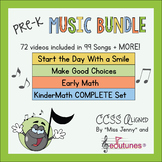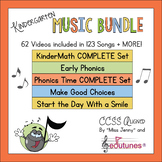Kindergarten Math Videos COMPLETE Set
- Streaming Video(cannot be downloaded)
- Supporting Information
Also included in
- This is a HUGE set of some of my most popular preschool songs, videos, and supporting materials--at a HUGE savings of 30% off!Songs are a GREAT way of creating an amazing pre-K classroom atmosphere. Use them for everything--From encouraging kids to SMILE at the beginning and end of each day, to promPrice $123.85Original Price $176.93Save $53.08
- This is a HUGE set of some of my most popular Kindergarten songs, videos, and supporting materials--at a HUGE savings!Songs are a GREAT way of creating an amazing Kindergarten classroom atmosphere. Use them for everything--From mastering math standards, to developing reading skills, to teaching kidsPrice $139.25Original Price $198.93Save $59.68
Description
Teach all aspects of Kindergarten math with these 31 research-based songs, matching videos, and activities! In study of 286 students, an independent researcher found that selected songs decreased anxiety, increased motivation, and increased mathematics achievement (see reference below). I have been revising them to become more and more effective for the last 20 years, with most recent revisions based on my 2016-2019 work in a Learning Design and Technology doctoral program. I'd love to be able to make a difference in your classroom with them!
Research indicates that you can maximize the effectiveness of videos if you use teaching strategies before, during, and after you play them. Please watch the preview to see how this can work. I've included part of the song "Making 11-20" to demonstrate. Sample ideas are for using this song are:
- Before playing the video: Ask students what they know about a number such as "12." Ask them to demonstrate what "12" means with their hands, with base tens blocks, and/or with drawings.
- While playing the video: At first, just watch. Later, ask two volunteers to imitate the video and demonstrate the concept to the class as the song plays. One child will show ten, and the other will add on. Individual students can also show concepts with base 10 blocks or drawings as the song plays. Sometimes, you may encourage students to read from lyric pages as they sing to promote reading fluency.
- After playing the video: Ask children what they noticed, and create mini-lessons based on their observations. Ask them to show numbers from the video in different ways. Promote reading by asking them to read the lyric page with the mp3 (song) version--or with no audio support.
You can access all 50+ minutes of these videos by pressing "play" through the TpT site.
Also, please click on the "Supporting Document" below the video and product information to get a LOT more:
1. Vimeo Links. I designed these videos to introduce, teach, and review individual topics--and I want you to have them as individual files so that you can use them one at a time or in any order you like. That's why I've added links for every individual video to my private Vimeo site (see the "Table of Contents" in the pdf file). You're welcome to stream or download the songs from this site.
2. Lyrics. I also want your students to connect math to reading. I've included lyric pages for all songs. Feel free to create books for your class year after year so that students can learn to read as they sing. Use lyric pages without the song--as a whole class, during guided reading groups, during partner work, and for independent reading.
3. Songs as mp3's. You'll also get a folder containing mp3 music only versions. These are great for doing activities during songs and for promoting reading. To promote math concepts, do activities such as they ones described above independently, without video support. To promote reading, ask children to point to words in lyric books as they sing. You will be surprised that some non- and early readers will learn to read from left to write, top to bottom, and find correct words since the lyrics follow the rhythm of the songs.
4. Teacher's Guide. This guide includes ideas for teaching content before, during, and after singing; manipulatives; centers; and more (100 pages including most activities in full-color and black-and-white).
5. BONUS: You'll also get access to ALL songs from one convenient page on my website. In order to receive this bonus...
- Please purchase the product and take note of your order number.
- E-mail me at missjenny@edutunes.com with your order number. Please also write: "I certify that I will only use each license purchased in one classroom or home. If other teachers or parents ask, I will let them know that they are required to purchase a license." (Note that due to issues with Coronavirus, you are able to share your license with your students' families at this time.)
***Note that first grade teachers may be interested in my 38-Video First Grade Math COMPLETE Set: Click HERE!
***You may also like my Phonics Time COMPLETE Video Set (click HERE), which motivates students as they learn everything from the ABC's to the "Magic e" and more!
The following are the songs on this program (in the order of the Common Core State Standards), with times.
Counting and Cardinality Songs
CCSS.Math.Content.K.CC.A.1 - Count to 100 by ones and by tens.
1. 100th Day of School 0:00
Note: There are 2 versions of this song on Vimeo. I've linked to both in the packet.
2. Count By 10’s 1:55
CCSS.Math.Content.K.CC.A.2 - Count forward beginning from a given number within the known sequence (instead of having to begin at 1).
3. Counting On 3:06
CCSS.Math.Content.K.CC.A.3 - Write numbers from 0 to 20. Represent a number of objects with a written numeral 0-20 (with 0 representing a count of no objects).
Count to tell the number of objects.
CCSS.Math.Content.K.CC.B.4 - Understand the relationship between numbers and quantities; connect counting to cardinality.
CCSS.Math.Content.K.CC.B.5 - Count to answer "how many?" questions about as many as 20 things arranged in a line, a rectangular array, or a circle, or as many as 10 things in a scattered configuration; given a number from 1-20, count out that many objects.
4. Write 0-9 4:26
5. Write 10-20 7:29
6. 10 Playful Puppies 10:49
7. Count With Me 11:57
CCSS.Math.Content.K.CC.C.6 - Identify whether the number of objects in one group is greater than, less than, or equal to the number of objects in another group, e.g., by using matching and counting strategies.1
CCSS.Math.Content.K.CC.C.7 - Compare two numbers between 1 and 10 presented as written numerals.
8. Alligator Greater Than/Less Than 12:59
Operations and Algebraic Thinking Songs
CCSS.Math.Content.K.OA.A.1 - Represent addition and subtraction with objects, fingers, mental images, drawings, sounds (e.g., claps), acting out situations, verbal explanations, expressions, or equations.
CCSS.Math.Content.K.OA.A.2 - Solve addition and subtraction word problems, and add and subtract within 10, e.g., by using objects or drawings to represent the problem.
CCSS.Math.Content.K.OA.A.3 - Decompose numbers less than or equal to 10 into pairs in more than one way, e.g., by using objects or drawings, and record each decomposition by a drawing or equation (e.g., 5 = 2 + 3 and 5 = 4 + 1).
CCSS.Math.Content.K.OA.A.4 - For any number from 1 to 9, find the number that makes 10 when added to the given number, e.g., by using objects or drawings, and record the answer with a drawing or equation.
CCSS.Math.Content.K.OA.A.5 - Fluently add and subtract within 5.
9. Alligator 1 More 14:09
10. Butterfly Addition 15:26
11. Adding Zero 17:57
12. Add 1 More 19:36
13. Add to Make 4, 5 20:43
14. Know Those 10’s 22:23
15. Zero the Hero 23:05
16. Any Number Minus Zero 25:59
17. Minus 1 27:40
18. Butterfly Subtraction 28:48
19. Do You Know Subtraction Facts? 31:23
20. 10 Little Monkeys 32:46
Number & Operations in Base 10 Songs
CCSS.Math.Content.K.NBT.A.1 - Compose and decompose numbers from 11 to 19 into ten ones and some further ones, e.g., by using objects or drawings, and record each composition or decomposition by a drawing or equation (such as 18 = 10 + 8); understand that these numbers are composed of ten ones and one, two, three, four, five, six, seven, eight, or nine ones.
21. Making 11-20 34:54
Measurement & Data Songs
CCSS.Math.Content.K.MD.A.1 - Describe measurable attributes of objects, such as length or weight. Describe several measurable attributes of a single object.
CCSS.Math.Content.K.MD.A.2 - Directly compare two objects with a measurable attribute in common, to see which object has "more of"/"less of" the attribute, and describe the difference. For example, directly compare the heights of two children and describe one child as taller/shorter.
22. Ant Comparisons 37:11
CCSS.Math.Content.K.MD.B.3 - Classify objects into given categories; count the numbers of objects in each category and sort the categories by count.
23. Name That Category 39:00
Geometry Songs
CCSS.Math.Content.K.G.A.1 - Describe objects in the environment using names of shapes, and describe the relative positions of these objects using terms such as above, below, beside, in front of, behind, and next to.
CCSS.Math.Content.K.G.A.2 - Correctly name shapes regardless of their orientations or overall size.
24. Let’s Do a Little Math 40:33
25. Circles Go ‘Round and ‘Round 42:39
26. Pentagon, Hexagon, Octagon 43:53
27. A Circle and a Square 44:51
CCSS.Math.Content.K.G.A.3 - Identify shapes as two-dimensional (lying in a plane, "flat") or three-dimensional ("solid").
CCSS.Math.Content.K.G.B.4 - Analyze and compare two- and three-dimensional shapes, in different sizes and orientations, using informal language to describe their similarities, differences, parts (e.g., number of sides and vertices/"corners") and other attributes (e.g., having sides of equal length).
28. Flat and Solid Shapes 46:33
29. Solid Shapes 48:05
30. It’s an Oval (Bonus) 50:09
31. Trapezoid (Bonus) 51:02
Referenced Study: Kocabaş, Ayfer. Using songs in mathematics instruction: Results from pilot application.” Procedia - Social and Behavioral Sciences, World Conference on Educational Sciences: New Trends and Issues in Educational Sciences, 1, no. 1 (2009): 538–43. doi: 10.1016/j.sbspro.2009.01.097.



